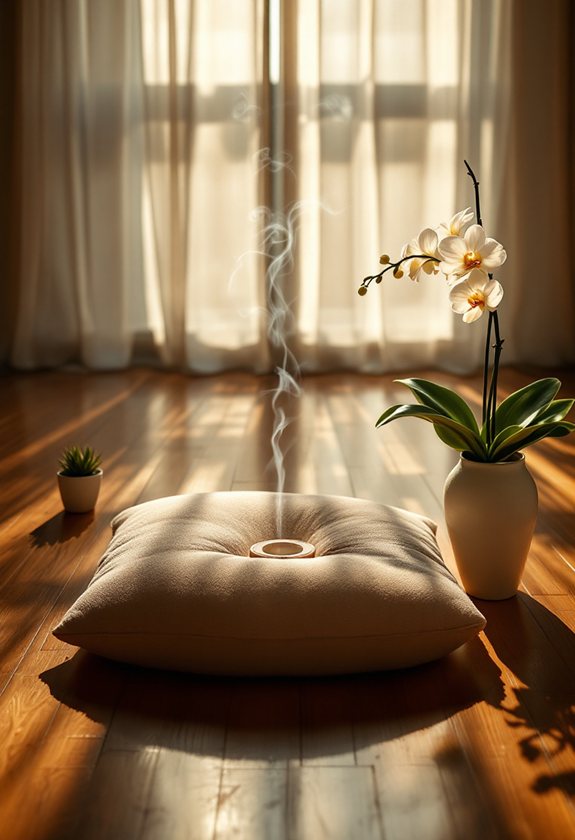Stillness reveals your creative genius by tapping into your brain’s Default Mode Network, which Dr. Aaron Kucyi links to fresh ideas through mind-wandering. When you take strategic breaks—like ten minutes of quiet reflection—you organize thoughts, cut distraction, and reduce mental overload. This mental clarity sharpens problem-solving and sparks insight, as Dr. Mark Beeman notes. Simple rituals, such as mindful breathing, quickly prepare you for creative flow. Stick around to uncover ten actionable strategies that enhance your creative breakthrough potential.
Key Takeaways
- Stillness activates the brain’s default mode network, sparking creative insights through mindful mind-wandering and spontaneous idea generation.
- Pausing and minimizing distractions clears mental clutter, freeing cognitive resources for original thinking and innovative solutions.
- Creating quiet, organized environments supports mental space, reducing cognitive overload and enhancing clarity for deeper creativity.
- Mindful stillness boosts problem-solving by fostering fresh perspectives, improved intuition, and better decision-making.
- Establishing creative rituals and presence practices during stillness conditions the mind for flow, sustained focus, and inspired action.
Activating the Brain’s Default Mode Network
Activating the brain’s Default Mode Network (DMN) is a significant step in releasing your creative genius. When you engage in DMN activation, you tap into regions like the medial prefrontal cortex and posterior cingulate cortex, vital for creative brainstorming.
To foster DMN activity, try stepping away from demanding tasks and allow your mind to wander—this is when fresh ideas often emerge.
Step away from demanding tasks and let your mind wander—this is when your most original ideas often surface.
- Practical Steps for DMN Activation:
- Set aside 10 minutes for quiet reflection.
- Let your thoughts drift without judgment.
- Use open-ended prompts, such as “What new ways can I help others today?”
According to Dr. Aaron Kucyi, “DMN activity is fundamental for divergent thinking and novel idea generation.”
Harness this network, and you’ll access creativity that serves others.
Enhancing Insight Through Mindful Mind-Wandering
While mindfulness and mind wandering might seem like opposites, learning to balance both can improve your creative insight.
Practicing mindful toggling—intentionally shifting between focused attention and curious daydreaming—lets you access both deliberate and spontaneous thinking. This approach helps you avoid getting stuck in habitual responses and creates space for unexpected connections.
- Use mindfulness to ground yourself before intentionally letting your mind wander.
- Engage in curious daydreaming by gently exploring ideas without judgment.
As Dr. Jonathan Schooler, a leading researcher, notes, “The most creative solutions often emerge during moments of spontaneous thought.”
Creating Mental Space for Original Ideas
Before you can generate original ideas, it’s crucial to create mental space—a cognitive environment where concepts can be organized, examined, and transformed. When you practice stillness, you allow your mind to step back from constant sensory input, making room for mental organization and idea prioritization. Think of this space as a navigable terrain, where you position and connect thoughts deliberately.
| Step | Benefit |
|---|---|
| Decouple from distractions | Frees resources for new ideas |
| Organize thoughts spatially | Reduces mental clutter |
| Prioritize ideas | Clarifies creative direction |
As creativity expert Dr. Mark Beeman notes, “Stillness increases access to deeper cognitive layers.” Use quiet moments to mentally map your ideas, focusing on relationships and potential. This structured approach supports originality and helps you serve others with groundbreaking solutions.
Sharpening Problem-Solving Abilities
Once you’ve carved out mental space for fresh ideas, it’s time to sharpen your problem-solving abilities through the power of stillness. When you pause, your brain’s default mode network activates, enhancing focus and cognitive flexibility. This allows you to approach challenges with fresh problem-solving techniques and clarity.
Sharpen problem-solving through stillness—pausing activates your brain’s creativity and clarity, helping you tackle challenges with fresh insight.
As you serve others, you’ll notice that moments of stillness help you see problems from multiple perspectives, reducing overthinking and mental fatigue.
Practical Ways Stillness Improves Problem Solving
- Rest increases creativity by 40%, supporting groundbreaking solutions.
- Mindful observation in stillness improves analytical skills, according to Dr. Daniel Siegel: “Stillness nurtures deep insight.”
- Reduced stress fosters intuition and better decision-making.
Prioritize stillness daily. You’ll uncover novel, effective solutions—empowering you to help others thrive.
Supporting Nonlinear and Reflective Thinking
Cultivating nonlinear and reflective thinking means training your mind to move beyond step-by-step logic and welcome unexpected connections.
Stillness fosters the Default Mode Network (DMN), which, as neuroscientist Dr. Marcus Raichle notes, “enables spontaneous, internally directed thought.” This supports nonlinear exploration and opens space for reflective practices that are crucial for genuine creativity.
When you allow your mind to wander and pause, you serve others by finding groundbreaking ways to solve complex challenges.
- Practice daily reflective pauses, letting ideas incubate without immediate judgment.
- Design environments that encourage curiosity and nonlinear exploration.
- Incorporate structured training to improve your brain’s neuroplasticity for creative growth.
- Step back from rigid logic, allowing diverse insights to blend into new solutions.
Reflective practices reveal your capacity for originality and service.
Reducing Cognitive Overload and Distraction
While it’s tempting to multitask in a world full of notifications and information, reducing cognitive overload is essential for accessing your creative genius. When you simplify your environment and focus on single tasks, you support your brain’s cognitive economy, reserving more mental resources for meaningful ideas.
- Minimize visual noise: Keep your workspace clear; less clutter means fewer distractions and greater mental clarity.
- Control digital interruptions: Schedule notification-free periods to prevent task-switching and protect your attention span.
- Filter sensory input: Use noise-canceling headphones or soft background music to block out unnecessary stimuli.
Dr. Amishi Jha, a neuroscientist, notes, “The mind’s best work occurs when it’s not overloaded.”
You’ll serve others more creatively by maintaining a clear, focused mind.
Boosting Productivity With Strategic Pauses
After clearing mental clutter and reducing distractions, the next step to releasing your creative genius is to strategically schedule pauses throughout your day.
Strategic pauses aren’t wasted time—they’re powerful productivity enhancers. According to productivity expert Cal Newport, “Deliberate breaks sharpen focus and decision-making, ultimately elevating your impact as you serve others.”
By weaving these intentional breaks into your workflow, you’ll notice sharper clarity, fewer errors, and a measurable productivity increase.
Use these proven strategies to enhance your impact:
- Two-minute reset: Before big decisions, pause to clarify objectives and question assumptions.
- Micro-break scheduling: Take 5–10 minute breaks every 90 minutes for improved focus and endurance.
- Weekly “dream” sessions: Dedicate 30 minutes to reflection and idea generation.
- Task-specific pauses: Align breaks with task demands to optimize your mental reset.
Fostering Emotional Balance and Self-Awareness
Although creativity thrives on inspiration, emotional balance and self-awareness provide the essential foundation for groundbreaking thinking.
To serve others well, prioritize self-reflective practices and mindful awareness. Use artistic outlets for emotional expression—transforming complex feelings into manageable insights while supporting creative resilience.
- Identify emotional triggers through regular self-reflection, sharpening personal insight and emotional intelligence.
- Practice stress management with mindfulness techniques like meditation, helping you pause and choose thoughtful responses rather than reacting impulsively.
Dr. Lisa Feldman Barrett, an expert in emotional intelligence, notes, “Awareness of your emotions is the primary step in harnessing their power creatively.”
Deepening Creative Flow States
Deepening creative flow states requires more than inspiration and emotional awareness—it’s about learning how to enter and sustain that heightened focus where ideas seem to generate effortlessly.
According to psychologist Mihaly Csikszentmihalyi, “Flow is the state in which people are so involved in an activity that nothing else seems to matter.”
To serve others well, you need to harness immersive experiences and creative rituals that allow your expertise to flourish.
- Establish creative rituals: Begin each session with actions that signal your brain to focus, like lighting a candle or playing soft music.
- Seek immersive experiences: Engage in environments that demand your full attention, reducing distractions.
- Set clear, meaningful goals: Define what you want to achieve before you start.
- Invite immediate feedback: Use tools or mentors to reflect on your progress instantly.
Cultivating Presence for Inspired Action
When you cultivate presence, you sharpen your awareness of actions, intentions, and surroundings, setting the stage for truly inspired action.
Presence practices, such as focused breathing or mindful observation, train you to move with intentional awareness. This means you’re not just reacting—you’re acting from a place of clarity and purpose, crucial for those aiming to serve others authentically.
To build presence, minimize distractions and regularly check in with your emotions. As leadership expert Tara Brach notes, “Real presence is a living, dynamic awareness.”
Try these steps:
- Start each day with five minutes of mindful breathing.
- Reflect on your core intentions before taking action.
- Routinely self-assess to identify triggers that disrupt your focus.
Consistency in these presence practices fosters inspired, purposeful action.
Conclusion
When you intentionally pause, you give your brain space to connect ideas and generate solutions. Neuroscientist Dr. Marcus Raichle notes, “Stillness activates the brain’s default mode network, essential for creativity.” To release your creative genius:
- Schedule daily quiet moments (10–15 minutes)
- Practice mindful breathing or guided meditation
- Reflect on problems without forcing answers
By making stillness part of your routine, you’ll notice more original ideas and sharper insights.






